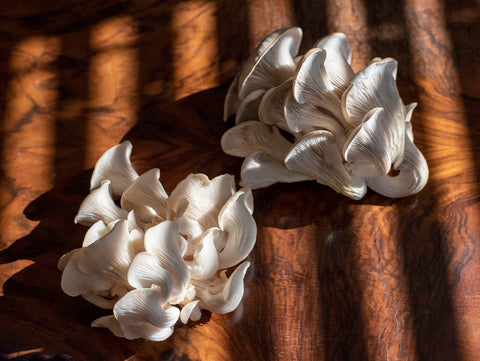Understanding Beta-glucans
We cannot discuss the benefits of functional mushrooms without talking about beta-glucans. In fact, this active compound is so important that I wanted to dedicate an entire blog post to it. Beta-glucans are a non-starch soluble polysaccharide widely present in yeast, mushrooms, bacteria, algae, barley, and oat (1). One of the reasons I wanted to focus on beta-glucans is because they are one of the most studied of the active compounds found in fungi. If you search for beta-glucans in google scholar, you will find many academic articles on the beneficial effects of beta-glucans. Ranging from regulating cholesterol to their anti-inflammatory and immunomodulating effects, there are countless studies that support these claims (2) (3).
Beta-glucans are polysaccharides; complex carbohydrates consisting of multiple sugar molecules linked together, found in the cell walls of fungi. Mushroom beta-glucans (MBGS) serve as a structural component, providing rigidity to the cell walls. Like all dietary fibers, they do not break down in the upper gastrointestinal tract, reaching the large intestine undigested. There, they undergo fermentation by the gut microbiota, which provides a huge potential benefits to the microbiome, essentially making beta-glucan a prebiotic (4).
A prebiotic is a type of non-digestible compound found in certain foods that promotes the growth and activity of beneficial microorganisms, such as bacteria, in the digestive system. Unlike probiotics, which are live beneficial bacteria themselves, prebiotics are substances that serve as nutrients for beneficial bacteria, helping them thrive and maintain a healthy balance in the gut microbiome. The most common prebiotics are dietary fibers. Check out this review by Lam et al. discussing the potential of beta-glucans as a novel source of prebiotics (5).

Stronger immunity
One of the most well documented effects of beta-glucans is on the immune system. Beta-glucans work as immunomodulating agents by activating immune cells such as macrophages, dendritic cells, granulocytes, and natural killer cells. This causes immune “effector” cells such as T cells and B cells to patrol the blood and tissues, and when they sense potential pathogens, they activate chemicals such as cytokines, resulting in the inhibition of tumor growth and metastasis or destruction of pathogens like viruses and bacteria (6).
An interesting study by Chen et al. (7) studied the effects of beta-glucans from the Reishi mushroom on natural killer cell-mediated cytotoxicity in mice and found that after taking the beta-glucan supplement for four days straight their natural killer cell function increased by 200%. The same study looked at the tumor inhibiting properties of MBGS as compared to radiation therapy only and showed that mice receiving the beta-glucan supplemented with radiation therapy had the best response, including less hair loss and milder wounds from the treatment.

The structure of beta-glucans
Beta-glucans in the cell walls of mushrooms are tightly bound with a tough glucose polymer called chitin (which is also found in insect exoskeletons). These bonds need either high temperatures or special enzymes to be broken down in order to make the beta-glucan more bioavailable. Thus, only about 20% of the beta-glucans are available without significant heating. Moreover, our bodies typically lack the enzymes to digest chitin so much of the mushrooms we eat end up as an insoluble fiber in our digestive system. While this is excellent food for our gut microbiota, the compounds we want to access end up locked inside of the chitinous cell walls. This means that we must cook our mushrooms thoroughly before eating them if we want to feel any benefit from the beta-glucans. This why mushroom extraction is so important. By using common extraction techniques, we can break down the chitin-beta-glucan bonds, giving us access to the latter.
Even though beta-glucans are found in all fungi, some species have much more of this active compound than others. Another interesting study by Sari and colleagues (8) looked at the beta-glucan content of various wild and commercially cultivated mushrooms, finding that the popular mushrooms Reishi and Turkey Tail have some of the highest beta-glucan content. This shouldn’t come as a surprise since these mushrooms have been used in traditional Chinese medicine for centuries. That said, oyster, shiitake, and honey mushrooms all contain a good amount of beta-glucans as well, so incorporating them into your diet is a great way to take in some of the health benefits described above.

Physical and Mental
We all know that our mind and bodies are connected. When our immune system has been weakened by constant stress, lack of sleep, and poor diet, this can affect our overall mood, energy levels, and ability heal. There are studies that have found evidence for similarities and overlaps between the immune and emotional responses (9). One particular study investigated the effect of humor on stress and immune function and found that patients who were shown comedic videos that made them laugh had a significant increase in natural killer cells and lowered stress levels (10).
After all, laughter is the best medicine, right? There are also studies that show exercise releases endorphins and serotonin that drastically improves your mood (11). One does not go without the other. We must think of our mental health and physical health as one!

Where do we go next?
We’ve only begun to scratch the surface of what these powerful mushrooms are capable of. Besides beta-glucans, there are hundreds of other compounds that we have yet to study. Luckily, we are living in a time where we have the technology for, and most importantly are open to, finding new answers. Over the last decade mushrooms have been in the spotlight and the amount of published literature has skyrocketed. This is a great thing because it means more money for research, which means we all get to benefit as a society. Many people are already using mushrooms as medicine to help with epilepsy, Alzheimer’s, cancer treatment, and much more. I recently learned that the Japanese ministry has been using Polysaccharide Krestin extracted from Turkey Tail mushrooms for the treatment of cancer since 1977! Now it’s time for the rest of us to catch up.


